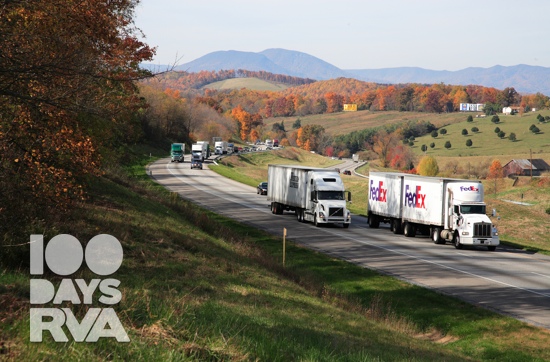Day #032: Develop an alternative strategy for dealing with congestion
The incredible cost of attempting and failing to reduce congestion.

Inspired by Michael Bierut’s 100 Day Project, 100 Days to a Better RVA strives to introduce and investigate unique ideas to improving the city of Richmond. View the entire project here and the intro here.
- Idea: Free tolls for full vehicles and enforce lane sorting by speed.
- Difficulty: 3 — VDOT’s lane funding incentivizes certain forms of development, and regulations stymie the exploration of alternatives.
From Los Angeles, California to Grand Forks, North Dakota and Nashville, Tennessee to Richmond, Virginia, every town seems to think it has a congestion problem.
The preferred method of addressing congestion in almost every city in America is road expansion. Unfortunately, according to a November 1998 study entitled “An Analysis of the Relationship Between Highway Expansion and Congestion in Metropolitan Areas,” roadway expansion often actually increases congestion.
In the study, the Surface Transportation Policy Project tracked 35 cities with high growth in road capacity and 35 cities with low growth in road capacity for 35 years.
Trends in congestion show that areas that exhibited greater growth in lane capacity spent roughly $22 billion more on road construction than those that didn’t, yet ended up with slightly higher congestion costs per person, wasted fuel, and travel delay.1
But this wasn’t a surprise. A study in California from 1973 to 1990 by UC Berkeley researchers Mark Hansen and Yuanlin Huang found that every 1% increase in new lane-miles at the metropolitan level generated a 0.9% increase in traffic in less than five years.
Despite all of this research, billions of dollars continue to be invested in increasing the lane capacity of metropolitan areas across the country. For example, VDOT is currently expanding a 4.52 mile stretch of I-64 in Goochland and Henrico from four lanes to six lanes. The sticker cost: $37.2 million or $8.23 million per mile. The opportunity cost: much, much higher including additional congestion in the short term, administrative costs, and environmental costs.
We can debate the causes of congestion and how roads change patterns of congestion. We can debate lane expansion and the costs of sprawl. These are all important conversations, but the fact remains that the region has an obligation to explore every means possible for the reduction of congestion as opposed to just chopping down trees and expanding the amount of pavement between residential areas and work areas.
The STPP recommends “investigating a broader menu of congestion relief measures that include other transportation modes, new technology, pricing, land use, and other strategies.” There are plenty of popular alternatives to expanding lanes including bus rapid transit, light rail, a bus system that effectively extends into the suburbs, mortgages that take commutes into account, and peak driving charges. Some of these will be future topics in this project and others have been thoroughly explored elsewhere.
For now, I’m going to explore two cheaper and simpler alternatives: free tolls for group commuters and enforcing rules that keep slower vehicles in the right lane.
Free tolls for highly occupied vehicles
Why is so much energy invested in maximizing the space on the road while almost no energy is invested in limiting the number of cars on the road? Carpooling saves money in gasoline and spares riders the stress of driving. The city can further enforce this practice by exempting all cars with three or more riders from tolls on the Downtown Expressway.
Enforce lane sorting by speed
Anyone who has been trapped behind a semi eternally passing another semi on I-81 between Blacksburg and Harrisonburg understands the importance of sorting lanes.
Students are trained to drive in the right lane and pass in the left lane in drivers education. Like most things learned at the age of 16, what the textbook say is often abandoned in favor of personal convenience; it’s the tragedy of the commons at 45 mph. If everyone followed the rules then the entire system would function more effectively for everyone, but the temptation of not being a “sucker” is just too grand.
— ∮∮∮ —
Whether it’s at the DMV or in a small town, people across the country complain about congestion. The only thing more universal than the complaints is the singular commitment to attempting to solve the problem of congestion by adding lanes. There is a time and a place for this solution, but its sticker price is exorbitantly high and it often comes at the cost of investing in alternatives. Richmond and its political and community leaders need to explore and even invent alternatives in order to build a sustainable, convenient, and worthy network of transportation.
Love this idea? Think it’s terrible? Have one that’s ten times better? Head over to the 100 Days to a Better RVA Facebook page and join in the conversation.
Photo by: VaDOT
- In Nashville, the STPP study estimates that maintaining current levels of congestion would require adding 101.35 lane-miles per year which would cost $3,243 for a family of four. To put it in perspective: If that family of four has two wage earners who lose 10 minutes each per day, and they each make $20 an hour, then they are losing $1,667 per year in income–a far cry from the $3,243 per year sticker price. ↩
-
Recommend this
on Facebook -

Report an error
-

Subscribe to our
Weekly Digest





There are 5 reader comments. Read them.